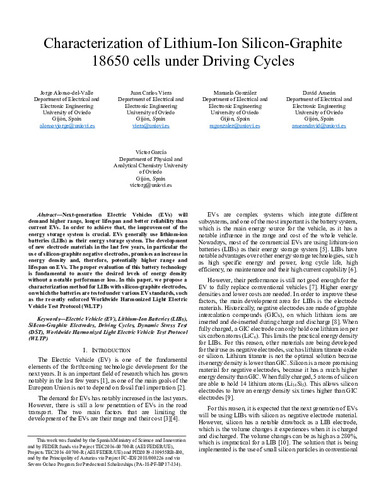Characterization of Lithium-Ion Silicon-Graphite 18650 cells under Driving Cycles
Palabra(s) clave:
Electric Vehicle (EV)
Lithium-Ion Batteries (LIBs)
Silicon-Graphite Electrodes
Driving Cycles, Dynamic Stress Test (DST), Worldwide Harmonized Light Electric Vehicle Test Protocol (WLTP)
Fecha de publicación:
Editorial:
IEEE
Descripción física:
Resumen:
Next-generation Electric Vehicles (EVs) will demand higher range, longer lifespan and better reliability than current EVs. In order to achieve that, the improvement of the energy storage system is crucial. EVs generally use lithium-ion batteries (LIBs) as their energy storage system. The development of new electrode materials in the last few years, in particular the use of silicon-graphite negative electrodes, promises an increase in energy density and, therefore, potentially higher range and lifespan on EVs. The proper evaluation of this battery technology is fundamental to assure the desired levels of energy density without a notable performance loss. In this paper, we propose a characterization method for LIBs with silicon-graphite electrodes, on which the batteries are tested under various EV standards, such as the recently enforced Worldwide Harmonized Light Electric Vehicle Test Protocol (WLTP)
Next-generation Electric Vehicles (EVs) will demand higher range, longer lifespan and better reliability than current EVs. In order to achieve that, the improvement of the energy storage system is crucial. EVs generally use lithium-ion batteries (LIBs) as their energy storage system. The development of new electrode materials in the last few years, in particular the use of silicon-graphite negative electrodes, promises an increase in energy density and, therefore, potentially higher range and lifespan on EVs. The proper evaluation of this battery technology is fundamental to assure the desired levels of energy density without a notable performance loss. In this paper, we propose a characterization method for LIBs with silicon-graphite electrodes, on which the batteries are tested under various EV standards, such as the recently enforced Worldwide Harmonized Light Electric Vehicle Test Protocol (WLTP)
Descripción:
IEEE Vehicular Power and Propulsion Conference, VPPC 2020 (17th. 2020. Gijón)
Patrocinado por:
This work was funded by the Spanish Ministry of Science and Innovation and by FEDER funds via Projects TEC2016-80700-R (AEI/FEDER/UE) and PID2019-110955RB-I00, and by the Principality of Asturias via Project FC-IDI/2018/000226 and via Severo Ochoa Program for Predoctoral Scholarships (PA-18-PF-BP17-134).
Colecciones
Ficheros en el ítem




